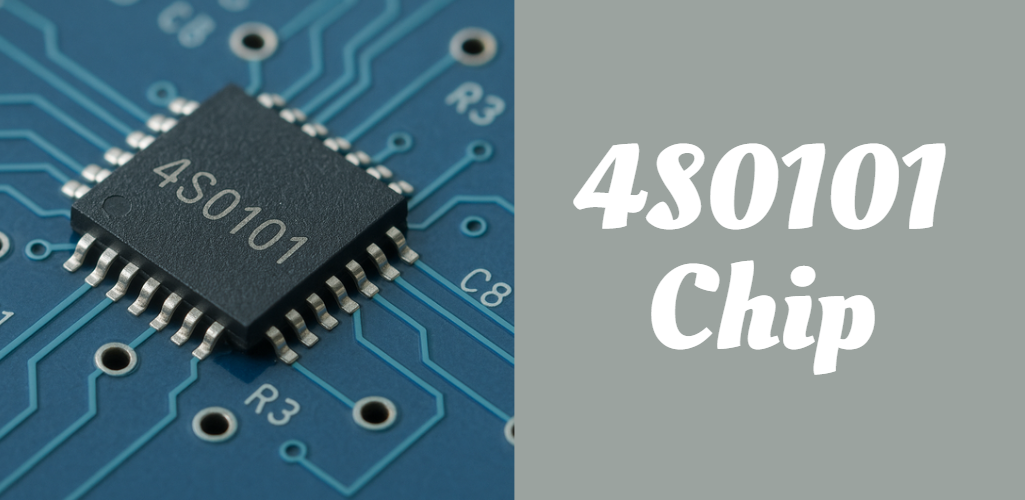What Is the 4S0101 Chip? Full Guide, Features, Applications & Benefits
The 4S0101 chip is a powerful yet compact programmable integrated circuit developed by Silego Technology, now under Renesas Electronics. Belonging to the innovative GreenPAK™ family, this chip has gained popularity due to its low-power operation, tiny footprint, and high level of integration.
Designed for use in a wide variety of modern electronic systems, the 4S0101 chip merges logic, analog, and mixed-signal capabilities into a single customizable solution. This makes it an ideal choice for engineers and developers looking for rapid design cycles, efficient power usage, and space-saving hardware in consumer electronics, automotive systems, wearables, and more.
Technical Specifications
The 4S0101 chip stands out because of its balance between simplicity and flexibility. Its core technical parameters are summarized below:
| Specification | Detail |
|---|---|
| Supply Voltage Range | 1.8V to 5.5V |
| Operating Temperature | -40°C to +85°C |
| Package Type | STQFN-20 (2 mm x 3 mm) |
| I/O Pins | Up to 18 configurable I/Os |
| Power Consumption | Ultra-low (typically in micro-watts) |
| Memory | One-time programmable (OTP) |
These specifications make the 4S0101 chip highly suitable for applications where space, power, and cost are critical design constraints.
Core Features
At the heart of the 4S0101 chip lies a suite of programmable features that can emulate traditional discrete components like logic gates, timers, counters, analog comparators, and voltage references. Instead of using multiple ICs, engineers can configure a single 4S0101 chip to execute complex tasks.
Some of its key features include:
- Programmable Logic Blocks: These can be used to create custom logic circuits such as AND, OR, XOR, and more, enabling flexible digital signal processing.
- Analog Functionality: It integrates analog comparators, voltage references, and even basic ADC functionality.
- Flexible I/O Configurations: Input/output pins can be configured for various roles including push-pull, open-drain, or analog input.
- Internal Oscillators and Timing Functions: These eliminate the need for external crystals in many timing-sensitive applications.
- Non-volatile Memory: The one-time programmable (OTP) memory stores user configurations even after power loss.
Thanks to this wide array of internal resources, the 4S0101 chip can significantly reduce the number of external components needed in a system.
Design and Development Tools
Developing with the 4S0101 chip is both fast and straightforward, especially with the support of Silego’s proprietary development environment—GreenPAK™ Designer Software. This intuitive GUI-based platform allows engineers to graphically design circuit configurations and simulate their operation in real time before committing to the OTP memory.
Once the design is complete, the chip can be programmed using a development kit via a standard USB interface. The system also includes debugging features such as internal signal monitoring, real-time testing, and emulation using virtual hardware.
For first-time users or rapid prototyping, the tool provides design templates and community-shared projects to jumpstart development.
Application Areas
Thanks to its compact design, low energy footprint, and highly customizable nature, the 4S0101 chip finds use across multiple industries. Below are some of the major application domains:
- Consumer Electronics – Power sequencing, button control, LED drivers
- Industrial Automation – Sensor interface, power monitoring, relay drivers
- Automotive Electronics – Lighting control, battery sensing, signal conditioning
- Medical Devices – Compact wearable monitors, sensor calibration
- IoT and Smart Devices – Remote control systems, smart tags, compact controllers
Its use in these sectors highlights how the 4S0101 chip meets both the space constraints and the need for programmable functionality across different platforms.
Advantages and Benefits
One of the biggest reasons behind the growing adoption of the 4S0101 chip is its broad set of advantages. These include:
- High Integration: Combines analog and digital functions in one IC, reducing component count.
- Compact Size: The small package is ideal for wearable tech and portable gadgets.
- Low Power Usage: Perfect for battery-powered applications with stringent energy budgets.
- Cost Efficiency: Reduces bill-of-materials (BOM) cost by replacing multiple discrete ICs.
- Design Flexibility: Engineers can tailor the chip’s functionality to their specific needs, reducing development time.
All these benefits allow developers to create smarter, faster, and more efficient devices with minimal hardware complexity.
Limitations and Considerations
Despite its versatility, the 4S0101 chip does have some limitations that designers should be aware of:
- OTP Nature: Since the chip is one-time programmable, any changes after configuration require replacing the chip.
- Resource Constraints: While it’s highly integrated, it may not be suitable for very complex logic or processing tasks that require large memory or multi-core CPUs.
- Limited Scalability: It’s best suited for compact, low-complexity applications. For more demanding tasks, FPGAs or MCUs may be more appropriate.
Understanding these limitations helps ensure that the 4S0101 chip is used in the right type of application for maximum benefit.
Case Studies and Real-World Implementations
The 4S0101 chip has been successfully implemented in a variety of real-world scenarios. A few notable examples include:
- Smartphones: Used to manage power buttons, proximity sensors, and LED drivers in tight board spaces.
- Industrial Sensors: Deployed in rugged environments for controlling relay switches and monitoring voltage thresholds.
- Automotive Lighting: Controls interior ambient lighting with PWM dimming and voltage sensing.
- Medical Devices: Implemented in lightweight, wearable health monitors to reduce board complexity and extend battery life.
These case studies highlight how versatile and reliable the chip can be when used strategically.
Future Developments and Trends
As electronics continue to move toward miniaturization and energy efficiency, the importance of chips like the 4S0101 will only grow. Future trends include:
- Integration with IoT Platforms: Enhanced support for smart sensors and actuators.
- Cloud-Connected Debugging Tools: Easier firmware updates and diagnostics through cloud-based development kits.
- New GreenPAK Variants: Higher-density chips offering greater flexibility and lower costs.
The growing ecosystem around GreenPAK technology ensures continued support and innovation for developers using the 4S0101 chip.
Conclusion
The 4S0101 chip is a game-changing solution for developers looking to simplify circuit design without compromising on functionality or power efficiency. It combines analog and digital capabilities in a single low-power package that supports a wide array of use cases—from wearables to industrial systems.
With tools like GreenPAK Designer, fast prototyping is possible even for novice developers. As more industries move toward compact, connected solutions, the relevance and utility of the 4S0101 chip are only set to rise.
Whether you’re an electronics hobbyist or a professional product designer, integrating the 4S0101 chip into your project could be the key to smarter, sleeker designs.
Recommended Articles
Is 805-354-1683 a Scam? Full Review, Warnings & How to Protect Yourself
Gugequshi: The Art of Chinese Storytelling Through History, Culture and Modern Revival
Complete Guide to http://164.152.29.41:app – Remote Software Deployment Portal Explained
Your Ultimate Guide to www.befitnatic.com – Fitness, Wellness & Lifestyle in One Place






